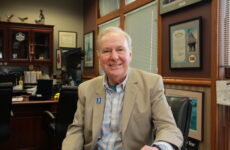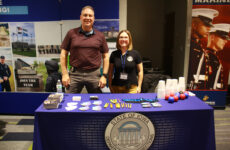
Julie Simanski (left) and Eden Pearson (right) during their Marriage & Family and Composition II class
DMACC’s Ankeny campus provides students with “learning community” opportunities. Learning communities are classes that allow students to work in a small group setting with two different instructors while completing two different classes.
Students are used to being taught one subject at a time: Math, History, Sociology, English, etc. Learning communities are designed to teach a subject, but relate it to the skills you learn elsewhere, including the real world.
For example, this semester learning community classes include Composition II, taught by Eden Pearson, combined with Marriage and Family, which is taught by Julie Simanski. Therefore, instead of writing just another research paper, students in the class are writing a paper relating to the sociology subject. The Marriage-and-Family-Composition learning community is intended to teach more than Sociology or English would separately. Instead, its intent is to teach these subjects combined, and how they relate to the student.
Both professors have been with DMACC for over 20 years and have enjoyed teaching this and other learning communities at DMACC. Learning communities are about “approaching college from an interdisciplinary perspective, in which you can combine the teaching and the content of two subject matters, and blend them into one,” Simanksi said.
Learning communities at DMACC are often stumbled upon or are heard about through word of mouth, but for many students they may be a great tool to help them succeed in school. This is because learning communities are smaller classes where you spend more time with your classmates and you have more time with the instructors.
“One of the benefits that I like about learning communities at a community college is because it is the same cohort of students for both classes. The connections are not only being made between the two disciplines but also between the students because they are spending more time together. And, because the faculty members are working together from their disciplines, there’s connections being made there [too]. So I see it as kind of a win, win, win for everybody,” Pearson said.
The structure of each learning community varies depending on the instructors and how they want to tie together the subject matters. At DMACC, learning communities are often made up of a skill-based class, like speech or writing, combined with a vocational or humanities class, like criminal justice, culinary arts, or sociology. That way the skill is applied to the vocation, just like in the real world.
“Sometimes they are created for a particular discipline. I taught one last semester with culinary arts and fundamentals of speech. So, all the things [students] talk about are related to their culinary arts program. They would go on field trips, and on that part of it, they had to pay attention to the different communication skills . . . and then write up a summary of that,” Simanski said.
Combining a vocation class and a skill based class can really benefit students, explains Pearson, “If people have chosen a vocation and they really want to be a chef or they really want to be a nurse, if you can take for instance writing for me or speech for Julie and have them write or talk about that, it is just so much better because the learning is multiplied.”





Comments